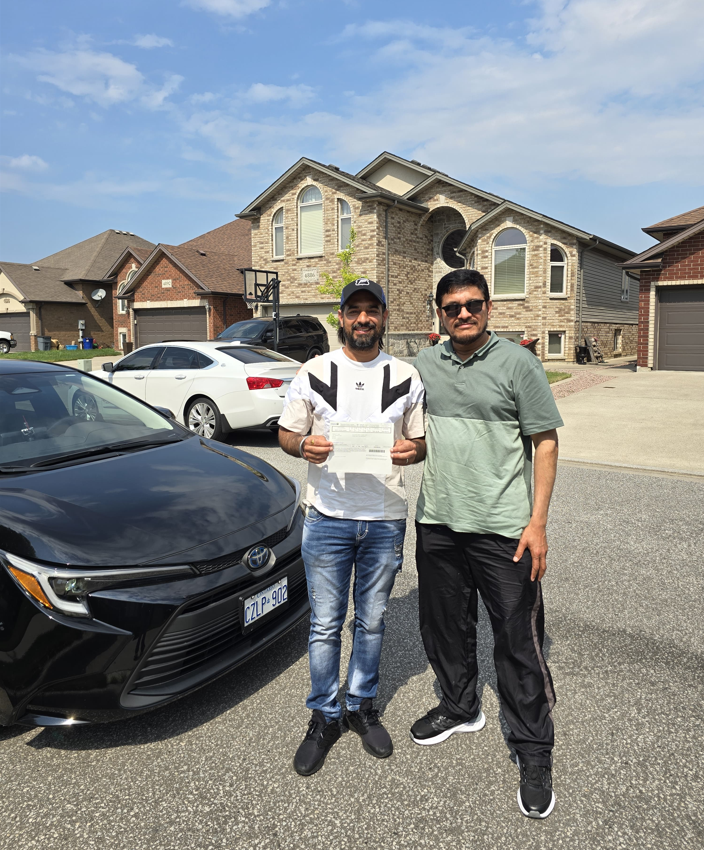Ontario G2 Road Test: Step-by-Step Guide
Published on
Earning your G2 license represents a crucial step toward driving independence in Ontario. While the road test can seem intimidating, strategic preparation and understanding what examiners look for can significantly boost your success rate. This comprehensive guide provides proven strategies to help you pass your G2 road test on your first attempt.
Essential Mirror and Blind Spot Techniques
One of the most critical skills examiners watch for is proper observation. Here are the key techniques that can make or break your test:
- Be a "Bobble Head": Exaggerate your head movements when checking mirrors and blind spots. Turn your head noticeably so the examiner can clearly see you're looking
- Mirror Check Frequency: Check your rearview mirror every 5-8 seconds, and side mirrors before every lane change or turn
- Blind Spot Protocol: Always do a shoulder check before changing lanes - make it obvious by turning your head 90 degrees
- Three-Point Mirror Check: Before any maneuver, check rearview mirror, then side mirror, then blind spot in that order

Smart Parallel Parking Strategies
Parallel parking is often the most feared part of the test. Use these insider tips to ace this maneuver:
- Driveway Awareness: Never attempt to parallel park in front of a driveway. If the examiner asks you to park there, politely say "That's a driveway, would you like me to park elsewhere?"
- Space Assessment: Look for spaces that are at least 1.5 times your vehicle length - don't attempt tight spaces
- Signal Early: Signal your intention to parallel park well before you start the maneuver
- Go Slow: Take your time - there's no rush. Better to be slow and accurate than fast and hit the curb
- Practice the Reference Points: Know where your vehicle's reference points are for aligning with the curb
Advanced G2 Test Preparation Strategies
Defensive Driving Techniques for Test Success
Demonstrating defensive driving skills is crucial for G2 test success. Examiners look for drivers who anticipate potential hazards and respond appropriately to changing conditions.
- Hazard Recognition: Continuously scan the road ahead for potential dangers, including pedestrians, cyclists, and other vehicles
- Space Management: Maintain appropriate following distances and create escape routes when possible
- Speed Adjustment: Reduce speed in school zones, residential areas, and when approaching intersections
- Weather Awareness: Adapt your driving style to current weather conditions, even during good weather
Mastering Complex Intersections
Intersection navigation is a critical component of the G2 test. Understanding different intersection types and their specific requirements will significantly improve your chances of success.
- Four-Way Stops: Follow the "first come, first served" rule, with right-of-way going to the right when vehicles arrive simultaneously
- Traffic Lights: Understand advanced greens, protected turns, and the meaning of flashing signals
- Roundabouts: Yield to traffic already in the circle and signal your exit appropriately
- Uncontrolled Intersections: Treat as four-way stops and proceed with extreme caution
Advanced Parking Maneuvers
While parallel parking is often the most feared maneuver, mastering all parking techniques is essential for G2 success.
Parallel Parking Mastery
- Reference Point Method: Learn your vehicle's specific reference points for accurate positioning
- Angle Adjustment: Practice entering at the correct angle (typically 45 degrees) for smooth parking
- Distance Judgment: Develop the ability to judge safe distances from other vehicles and curbs
- Multiple Attempts: Understand when to restart a parking maneuver rather than forcing an unsafe position
Other Essential Parking Skills
- Reverse Parking: Master backing into parking spaces with proper mirror and shoulder checking
- Hill Parking: Understand wheel positioning and brake usage on inclines
- Perpendicular Parking: Practice parking at 90-degree angles in parking lots
Test Day Success Strategies
Pre-Test Preparation
Proper preparation in the days leading up to your test can make the difference between success and failure.
- Vehicle Familiarization: Practice in the same vehicle you'll use for the test
- Route Practice: Drive around the test center area to become comfortable with local traffic patterns
- Mock Tests: Complete full-length practice tests under realistic conditions
- Rest and Nutrition: Ensure adequate sleep and proper nutrition in the days before your test
During the Test
Maintaining composure and following proper procedures during the actual test is crucial for success.
- Listen Carefully: Pay close attention to examiner instructions and ask for clarification if needed
- Stay Calm: Use breathing techniques to manage anxiety and maintain focus
- Exaggerate Movements: Make mirror checks and shoulder checks more obvious than usual
- Commentary Driving: Verbally describe what you're observing to demonstrate awareness
- Take Your Time: There's no rush - better to be slow and accurate than fast and dangerous
Common G2 Test Mistakes to Avoid
Understanding common mistakes can help you avoid them during your test. Here are the most frequent errors that lead to G2 test failure:
Observation Errors
- Insufficient Mirror Checks: Not checking mirrors frequently enough or failing to make head movements visible
- Missing Shoulder Checks: Forgetting to check blind spots before lane changes or turns
- Poor Intersection Scanning: Not looking left-right-left at intersections or failing to check for pedestrians
Control and Positioning Errors
- Lane Drift: Allowing the vehicle to drift within the lane or across lane markings
- Poor Speed Control: Driving too fast or too slow for conditions
- Abrupt Steering: Making jerky or excessive steering movements
Traffic Rule Violations
- Rolling Stops: Not coming to a complete stop at stop signs
- Improper Signaling: Failing to signal or signaling too late for maneuvers
- Right-of-Way Errors: Not yielding appropriately to other vehicles or pedestrians
Building Confidence for Test Day
Confidence is often the deciding factor between passing and failing the G2 test. Here are strategies to build and maintain confidence:
Progressive Skill Building
- Start with Basics: Master fundamental skills before attempting complex maneuvers
- Gradual Progression: Increase difficulty gradually as skills improve
- Positive Reinforcement: Celebrate small victories and improvements
- Consistent Practice: Regular practice sessions build muscle memory and confidence
Mental Preparation
- Visualization: Practice mental rehearsal of successful test scenarios
- Positive Self-Talk: Replace negative thoughts with confident affirmations
- Stress Management: Learn and practice relaxation techniques
- Realistic Expectations: Understand that perfection isn't required, only safe driving
Success on your G2 road test requires dedication, practice, and the right preparation strategies. By following this comprehensive guide and working with experienced instructors, you'll be well-equipped to pass on your first attempt. Remember, the ultimate goal isn't just passing the test - it's becoming a confident, safe, and responsible driver for life. At Rajput Driving School, we're dedicated to helping you achieve this important milestone. Best of luck on your test, and drive safely!
Book Your LessonCategories
Recent Posts
- How to Parallel Park in 3 Easy Steps
- Top 5 Tips for Passing Your Driving Test in Windsor
- How to Choose the Right Driving School For You
- What Happens If You Fail The G1 Test?
- Step-by-Step Guide to Getting Your G1, G2, and G Driver's Licence
- The G2 Road Test Examination Sheet Explained
- 10 Defensive Driving Tips That Can Save Your Life
- What Happens If You Fail Your G Test in Ontario?
- Top 10 Reasons for Failing the G Road Test in Windsor, Ontario
- Winter Driving Safety: 10 Essential Tips
- 10 Reasons Why You Should Take Driver's Ed in Windsor, Ontario
- Common Mistakes People Make on Their G2 Driving Test
